The Hobbit: The 1977 Animated Television Movie
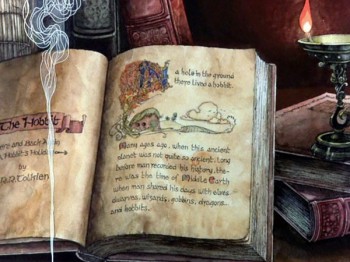 The Hobbit (NBC TV, 1977)
The Hobbit (NBC TV, 1977)
Directed by Jules Bass and Arthur Rankin Jr. Featuring the Voices of John Huston, Orson Bean, Hans Conried, Richard Boone, Theodore Gottlieb, Otto Preminger, Cyril Ritchard, Paul Frees, Don Messick.
A few years ago, in my early posting days on Black Gate, I wrote a lengthy overview of Rankin/Bass’s strange but oddly likable animated television movie of The Return of the King. I intended to review Rankin/Bass’s other Tolkien TV movie, The Hobbit, some time later. “Later” took the form of two years, give or take a day, but has become “now,” thanks to Peter Jackson.
With The Hobbit back in the front lines of entertainment news because of the start — finally! — of production on Peter Jackson’s two-movie adaptation of the book, it’s the appropriate time to re-visit the first film version of the story. A Long Expected Party for an old friend.
Full disclosure: I have an enormous nostalgic fondness for the 1977 animated Hobbit, since it introduced me to one of my favorite authors at a young age. This movie was my first exposure to anything related to J. R. R. Tolkien when I saw it at age five on its second network broadcast. I already adored monsters of any kind, branching off from a natural adoration of dinosaurs, and my mother told me that The Hobbit was a book chock-a-block full of strange beasts: goblins, trolls, dragons, giant spiders, giant eagles. Since I was still too young to read the book, I took up the movie as my Middle Earth introduction and loved every minute of it. When I read the book myself for the first time three years later, it was in a coffee table edition that used stills and production art from the Rankin/Bass production to illustrate Tolkien’s text. The combination of the TV broadcast and this edition of the book have made the Rankin/Bass movie an inseparable part of my Tolkien experience.
Nostalgia aside, I think that the 1977 animated version of The Hobbit stands up admirably as a piece of children’s entertainment. It achieved the feat of translating Tolkien’s materially as faithfully as the compressed medium allowed, and it will still seed in any young viewer the wish to experience the original for him or herself. I can argue some of the movie’s flaws, and will; but it pushed many young developing fantasy fans toward this seminal book and author, and for that it has my enduring respect.
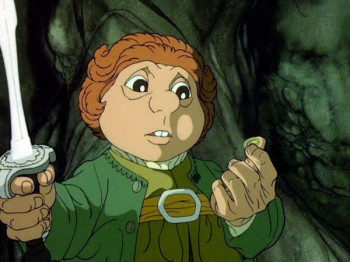 The Hobbit is more successful with its material than the Rankin/Bass follow-up of The Return of the King, but its source material is easier to translate into an eighty-seven minute child-friendly animated film than the last third of a huge novel aimed at adults. (I think The Return of the King turned out well considering what it was up against, but you can read my thoughts on that in glorious Metrocolor detail here.)
The Hobbit is more successful with its material than the Rankin/Bass follow-up of The Return of the King, but its source material is easier to translate into an eighty-seven minute child-friendly animated film than the last third of a huge novel aimed at adults. (I think The Return of the King turned out well considering what it was up against, but you can read my thoughts on that in glorious Metrocolor detail here.)
Most of the main sequences from the novel arrive on the screen in some form, with Beorn a prominent casualty. Writer Romeo Muller, who penned most of the Rankin/Bass holiday specials such as Frosty the Snowman and Rudolph the Red-Nosed Reindeer, was under instructions from Rankin and Bass not to insert anything into the story that wasn’t also present in Tolkien; although a number of elements are gone, nothing annoying got put in. Muller’s script executes some fine compressing of longer sequences into shorter ones, such as rapidly bringing together the Unexpected Party in the opening and having Smaug make only one exit from Lonely Mountain. The Battle of Fire Armies is also reduced to remove the Arkenstone and Bilbo’s manipulating of events; after Smaug’s death, the film gets in a hurry to finish up.
Although The Hobbit is not a “violent” story, some of its action had to get stylized for family-friendly television. The Rankin/Bass team sidestepped the problem of swordplay through editing and effects-animation tricks that make the weapons Sting and Glamdring into almost science-fiction devices. I can remember as a child wondering what exactly had happened to the Goblin King when Glamdring struck him, and why Sting caused the Mirkwood spiders to go into spinning split-screens. Looking at this today, I think it’s a clever way of making an impact without seeing an impact.
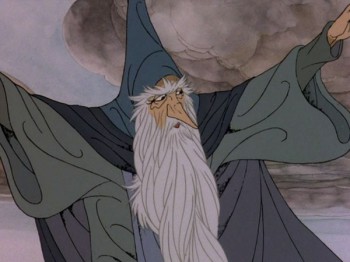 The decision to adhere to Tolkien whenever possible means that a number of the scenes contain astonishing poetry for a production aimed at young viewers. To explain the back-story of the dwarves and Smaug, the movie combines the Tolkien poem “Far over the Misty Mountains Cold,” which John Huston reads in a magnificent voice, with narration from Thórin (Hans Conried) over a collage of images for a haunting effect. What is particularly amazing here is that the script cuts not a single line from the original poem. Hearing Huston’s voice intone, “They fled their hall to dying fall / Beneath his feet, beneath the moon,” over the fiery images of Smaug’s destruction of the dwarves of Erebor is still spine-tingling. To build suspense, the imagery keeps Smaug almost unseen: a shadow over Dale, a roiling ball of fire in the roasting sky, blasts of heat searing trees.
The decision to adhere to Tolkien whenever possible means that a number of the scenes contain astonishing poetry for a production aimed at young viewers. To explain the back-story of the dwarves and Smaug, the movie combines the Tolkien poem “Far over the Misty Mountains Cold,” which John Huston reads in a magnificent voice, with narration from Thórin (Hans Conried) over a collage of images for a haunting effect. What is particularly amazing here is that the script cuts not a single line from the original poem. Hearing Huston’s voice intone, “They fled their hall to dying fall / Beneath his feet, beneath the moon,” over the fiery images of Smaug’s destruction of the dwarves of Erebor is still spine-tingling. To build suspense, the imagery keeps Smaug almost unseen: a shadow over Dale, a roiling ball of fire in the roasting sky, blasts of heat searing trees.
Other notable sequences are the goblins seizing the dwarves in the Misty Mountains (another great montage with a Tolkien poem), Bilbo’s lengthy debate with Smaug (although the power of Smaug’s voice is unmentioned), and the death of Thórin, which features a tearful reading of the novel’s dialogue — somewhat truncated — from voice actor Hans Conried: “There is more in you of good than you know, child of the kindly West. If more of us valued food and cheer and song above hoarded gold, it would a . . . merrier world. But sad or merry, I must leave it now. Farewell.”
Muller’s best original moment in his script, and one well realized in design and animation, comes from a short passage in Chapter VIII of the novel. Bilbo climbs up to the top of a tree in Mirkwood to get a sense of the lay of the land, and finds the roof of the woods filled with “black emperor” butterflies. For the movie, this is made into a central moment, and captures the change in Bilbo’s character throughout the novel in a good piece of animated shorthand. The image is a perfect capture of Tolkien’s prose, down to the trees “ruffled here and there by the breeze,” 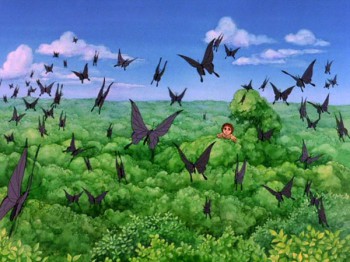 but Muller adds an excellent piece of first-person narration from Bilbo that mixes with a slow rendition of the original song “The Greatest Adventure” and Tolkien’s famous “Roads Go Ever On and On”:
but Muller adds an excellent piece of first-person narration from Bilbo that mixes with a slow rendition of the original song “The Greatest Adventure” and Tolkien’s famous “Roads Go Ever On and On”:
Over snow by winter sown,
And through the merry flowers of June,
Over grass and over stone,
Under the Mountains in the Moon. . . .
Bilbo: There are moments which can change a person for all time. And I suddenly wondered if I would ever see my snug little hobbit-hole again. I wondered if I actually wanted to.Let go of the moment,
That life makes you hold.
The strangeness of the musical interludes in The Return of the King, with the exception of the bonkers “Where There’s a Whip There’s a Way,” is not a problem in The Hobbit. Most of the musical pieces work because they come straight from Tolkien’s pen and therefore have a natural flow with the scenes, and their childlike wonder keeps with the novel’s tone. The two goblin songs, “Clap! Snap! the Black Crack!” and “Fifteen Birds in Five Firtrees,” benefit immensely from the deep rumble of Thurl “Tony the Tiger” Ravenscroft’s voice to create a genuine feel of menace. The sole original song, “The Greatest Adventure” written by Jules Bass and performed by folk singer Glenn Yarbrough, which also forms the backbone of Maury Laws’s instrumental score, meshes well with its Tolkien brethren and serves Bilbo as a character.
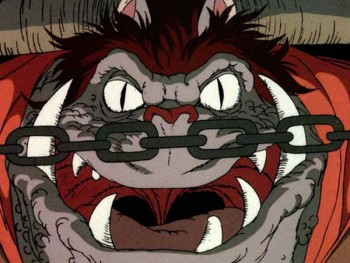 The animation of The Hobbit was done in Japan at Topcraft Studios, but the film was designed in the U.S., mostly by Arthur Rankin Jr. His style of rendering finely detailed lines on the characters and the backgrounds captures a feeling of turn-of-the century illustrations from classic children’s literature. This style would continue in a number of other Rankin/Bass animated films, including The Return of the King, The Last Unicorn, and Flight of Dragons. Although the animation is not at the level of large-budget theatrical film, or even the more modest Disney pictures of the decade, the overall look of The Hobbit is remarkably beautiful and feels like the Middle Earth of the book. Certainly, the appearance of the main characters — Bilbo, Gandalf, and Thórin — are wonderful and still dominate the way many fans think of these figures. The goblins’ look, which branched out into greater variety as the orcs in The Return of the King, remains much-liked for its monstrous fairy-tale appearance.
The animation of The Hobbit was done in Japan at Topcraft Studios, but the film was designed in the U.S., mostly by Arthur Rankin Jr. His style of rendering finely detailed lines on the characters and the backgrounds captures a feeling of turn-of-the century illustrations from classic children’s literature. This style would continue in a number of other Rankin/Bass animated films, including The Return of the King, The Last Unicorn, and Flight of Dragons. Although the animation is not at the level of large-budget theatrical film, or even the more modest Disney pictures of the decade, the overall look of The Hobbit is remarkably beautiful and feels like the Middle Earth of the book. Certainly, the appearance of the main characters — Bilbo, Gandalf, and Thórin — are wonderful and still dominate the way many fans think of these figures. The goblins’ look, which branched out into greater variety as the orcs in The Return of the King, remains much-liked for its monstrous fairy-tale appearance.
Any child who knew something of the story of The Hobbit back when the movie was first broadcast would be most fascinated to see what the great villain of the piece, the dragon Smaug, looked like. The movie did not disappoint them. The design of Smaug makes an interesting use of mammalian qualities, such as fur along his dorsal spine and on his jowls, and bat-like ears. Effects animation creates “spotlights” from Smaug’s peering eyes as he looks for Bilbo among his mounds of treasure, which generates genuine suspense during their conversation. But it is the thick voice of Richard Boone, famous for the television Western Have Gun — Will Travel, that sells the enormousness and vanity of the dragon. (Boone had worked recently with Rankin/Bass on a live-action movie they co-produced with Japanese company Tsubaraya Pro, The Last Dinosaur. I wish some U.S. distributor would put that out in Region 1 DVD or Blu-ray some day. Update Feb. 2013: Wish granted!) The script lets Boone’s Smaug cut loose with a full monologue about his powers that has thundering impact on the screen.
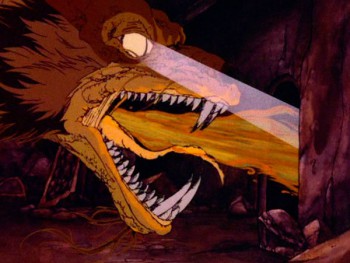 (Unfortunately, the same misunderstanding that leads to the mispronouncing of “Sauron” in The Return of the King shows up here when “Smaug” is mispronounced to rhyme with “Frog.”)
(Unfortunately, the same misunderstanding that leads to the mispronouncing of “Sauron” in The Return of the King shows up here when “Smaug” is mispronounced to rhyme with “Frog.”)
The production design does make one serious misstep that jars against the otherwise faithful feel of The Hobbit’s look: the elves. Or specifically, the wood elves, since none of this applies to Elrond’s appearance. Apparently, in an attempt to make the elves immediately distinguishable as separate from humans to the eyes of young viewers, and to make them somewhat “monstrous,” they are drawn as gray, awkward, bizarre creatures. Putting the heavy German accent of Otto Preminger into the mouth of the Elvenking Thranduil was also an odd choice, making it seem as if the dwarves stumbled across an SS encampment at the edge of Mirkwood. When Thranduil shows up for the Battle of Five Armies, he’s decked out in an hilarious helmet which makes him look like a drunk attendee at a Renn Fair who thinks he’s a “druid.” And I still can’t figure out why Elrond looks nothing like these Elves. Maybe his human genes are incredibly dominant?
Preminger aside, the voice acting is excellent, with John Huston as a standout playing Gandalf. As a child, this was my first encounter with Huston, and not until many years later would I realized that “the guy who was Gandalf’s voice” was also one of the great U.S. film directors. As much as I love Huston’s work as a director, especially on two personal favorite films, The Maltese Falcon and The Man Who Would Be King, there remains a part of my mind that associates him with Gandalf first. (And then as Noah Cross in Chinatown, but that’s another story.)
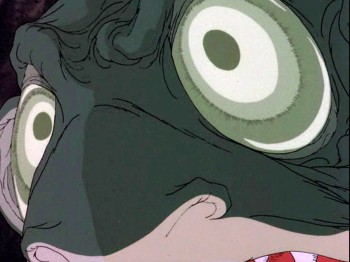 However, it’s Theodore Gottlieb, credited here as “Brother Theodore,” who is the voice highlight of the movie for his role as Gollum. I don’t have much to add about the movie’s presentation of Gollum that I didn’t already cover in the Return of the King review, so the fast summary: the design doesn’t match Tolkien’s concept of the character — this creature certainly was never a hobbit — but it looks great and Gottlieb’s performance indelible. The “Riddles in the Dark” is the movie’s best scene, and a surprising number of the riddles make it into the dialogue, with one of them (“The Dark”) turned into an eerie song performed by a female vocalist. Even as a child unaware of The Lord of the Rings, I knew there would be massive consequences from this sequence with this weird frog-creature and the magic ring. The design and execution leave no doubt about that. Try to erase Gollum’s final screams of “We hates it! We hates it . . . forever!” from your memory as they echo over an image of the mad creature’s pulsating eye.
However, it’s Theodore Gottlieb, credited here as “Brother Theodore,” who is the voice highlight of the movie for his role as Gollum. I don’t have much to add about the movie’s presentation of Gollum that I didn’t already cover in the Return of the King review, so the fast summary: the design doesn’t match Tolkien’s concept of the character — this creature certainly was never a hobbit — but it looks great and Gottlieb’s performance indelible. The “Riddles in the Dark” is the movie’s best scene, and a surprising number of the riddles make it into the dialogue, with one of them (“The Dark”) turned into an eerie song performed by a female vocalist. Even as a child unaware of The Lord of the Rings, I knew there would be massive consequences from this sequence with this weird frog-creature and the magic ring. The design and execution leave no doubt about that. Try to erase Gollum’s final screams of “We hates it! We hates it . . . forever!” from your memory as they echo over an image of the mad creature’s pulsating eye.
As any fan of animated fare of the 1960s and ‘70s will know, it is not animated fare of the 1960s or ‘70s until you have either Don Messick, Paul Frees, or Peter Fernandez doing voice work in it. Here we have both Don “Scooby-Doo” Messick (as Gwahir, Balin, one of the trolls, the goblin who says “He is a liar, O Tremendous One!”) and Paul “Ghost Host” Frees (as Bombur and one of the other trolls). Double score! No Peter “Speed Racer” Fernandez, however. Had this been an ‘80s or ‘90s movie, we would be talking about Frank Welker and Cree Summers.
Warner Bros. Home Video has released The Hobbit on DVD (originally with a street date of 11 September 2001 — the worst day to release anything) but the disc is currently out-of-print. I am keeping a close guard on my copy, but I think we can expect a re-release from Warner Bros. as the opening of Peter Jackson’s version closes in, probably with a Blu-ray disc as well. It is a film worth revisiting for any Tolkien fan, and serves the excellent purpose of indoctrinating children . . . FOREVER!
Ryan Harvey is one of the original bloggers for Black Gate, starting in 2008. He received the Writers of the Future Award for his short story “An Acolyte of Black Spires,” and his stories “The Sorrowless Thief” and “Stand at Dubun-Geb” are available in Black Gate online fiction. A further Ahn-Tarqa adventure, “Farewell to Tyrn”, is currently available as an e-book. Ryan lives in Los Angeles. Occasionally, people ask him to talk about Edgar Rice Burroughs or Godzilla in interviews.
Splendid review, Ryan!
It even made me go back and re-read your RETURN OF THE KING article, just to hear what you’d said about “Where There’s a Whip, There’s a Way,” a song that stayed firmly lodged in my mind (after hearing it once) for THREE DECADES. I still hum it on long forced walks.
I’m glad you quoted Thórin’s final lines to Bilbo. That was part of what elevated this film to a classic for me. That, and the wonderful rendition of “Misty Mountains Cold.” I wish I had the soundtrack, which was a popular item for a few years afterwards.
I dearly loved this movie, and it was one of the first DVDs I bought to share with my three children.
Well done, and great review of a classic. The only poem I’ve ever memorized is because of this movie and the voice of Huston… ah, it doesn’t get better than ‘Misty Mountians Cold’.
This movie almost put me off reading The Hobbit. As a lttle kid this film was a little scary. As an adult it’s easier to appreciate, though-the book, too. Great review!
[…] also like my 1977 Hobbit follow-up. The film isn’t as weird and grandly fun to write about, however—even if it is a much better […]
[…] http://www.blackgate.com/2011/03/29/the-hobbit-the-1977-animated-television-movie/ […]
[…] Screencaps from Black Gate […]
[…] status.) Boone would continue his association with Rankin/Bass in 1977 when he voiced Smaug for the animated version of The […]